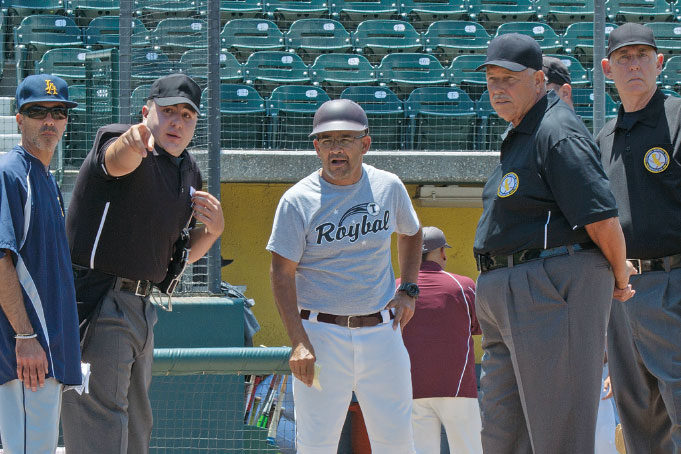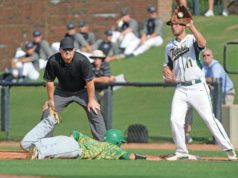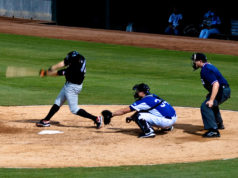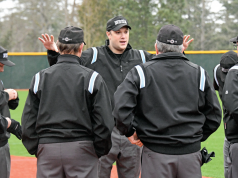Very few baseball fields are identical. While infields are all alike, size-wise, the shape of the outfield will vary and the alignment of outfield fences and the material used are unlikely to match another facility. The configuration of foul territory and the location of bullpens will also vary. Thus, there is a need for ground rules whose sole purpose is to identify the locations where a live ball becomes a dead ball.
The only restriction on ground rules is they cannot conflict with or supersede any printed rule. An example is the telephone cable which stretches between the plate and the backstop. Playing it off the wire makes sense as the wire is not apt to materially change the path of the ball; however, the rules provide a foul ball is dead when it touches anything foreign to the ground.
Another idea with merit is a ground-rule triple because the fence the ball goes through is so distant that any runner could easily make it to third. The problem is the rules state fair batted balls which go over or through a fence result in a two-base award. However, in a college game NCAA rule 8-3o1 permits a ground rule in this type of situation.
The home team coach is required to propose any ground rules at the pregame conference. If the visiting coach disagrees, the umpire-in-chief makes the final determination. The UIC may add any special ground rules, at his discretion (NFHS 4-1-2, 10-2-3a; NCAA 4-5; pro 4.05). If something occurs that is not covered, the UIC has authority to rule (NFHS 10-2-2; NCAA 3-6b; pro 8.01c).
In the vast majority of games, the review of ground rules is routine and the home coach spends most of the time explaining all the openings in the fences that the ball will never go through. However, if he proposes an incongruent rule, the umpire needs to proceed cautiously. It’s not a good idea to start a game with a confrontation over something that is not likely to happen. Of course, if safety is involved, the umpire must insist a change be made. In other cases, the prudent course may be to let the coach have it his way and later address the matter with the umpiring association or the assigning agency.
Coaches generally prefer to keep the ball live in as many scenarios as possible and there is merit to that, but it is not always sensible. On one local field, there are three sheds immediately behind and higher than a chain link fence beyond first base. The coach always proposes that if an overthrow (a somewhat possible scenario) goes over the fence and bounds back off a shed, the ball remains live.
On another field, the chain link fence is open (no gate) to a shed about a foot beyond the fence line. It is possible for a ball to go through the space between the shed and the fence and that would clearly be a dead ball, but the coach wants to play a ball that hits the shed and returns to the playing field.
In both cases above, the ball would leave the field and should become dead. Other examples of situations or field characteristics which may require ground rules include, but are not limited to: dugout facing, scoreboards, open bullpens, batting cages, fences or tarpaulins in which the ball may lodge, sloped areas, unusual or temporary ground conditions, overhanging tree limbs, cables, power lines, poles, bunting, parked cars or other manmade devices within the playing field or an overflow of spectators onto the playing field.
In formulating or approving ground rules, safety should be foremost. Players should not be allowed to chase balls into open creek beds, rocky slopes, open pits, large puddles or muddy areas. Jumping up on tarpaulins or ledges should also be forbidden.
Simplicity, for both players and umpires, is also a consideration. The umpires are the ones who have to figure out what the ball actually hit. Ground rules which create great difficulty are those which seek to keep live a ball which hits off a specified portion of a dead-ball area. Examples are dugout facades which are set back from the dead-ball line or posts inside the dugout. The problem with the latter is it may be difficult to discern whether the ball hit the post, the helmet lying next to it or the back wall.
Another aspect of dugouts which may require attention is the dugout extension, a somewhat common modification in amateur games because many fields have small dugouts. The home team may ask for a certain area adjacent to the dugout to be considered part of the dugout so that equipment may be stored there. The umpires must ensure the limits of the extension are clearly defined and that it complies with the requirement that it be on the outfield side and no closer to the foul line than the dugout itself. The extension must be the same for both teams (NFHS 1-2-4; NCAA 1-16).
NFHS rules provide for a designated media area. In most prep games there isn’t any value in having such a dead-ball area, but when it’s needed it means the game means more than usual. An umpire’s first responsibility is to ascertain the media area is placed in an innocuous location. Obviously it is going to be against a fence, but any spot in a direct line with a throw from the third baseman around to a throw from the second baseman is not a good idea.
A ball is immediately dead if it hits someone within or partially within a designated media area (1-2-8). If the person is totally outside the marked area when contacted, it is treated as spectator interference. The ground rules sometimes stipulate an unoccupied media area remains live-ball territory; that’s possible by defining a media area as “a designated area occupied by media personnel.”
Throws from dead-ball territory require special mention. Under all codes, such a throw can never be made and no ground rule can change that. The ball is always dead when carried into a dead-ball area (NFHS 5-1-1i, NCAA 6-1d; pro 5.06b3C).
Above all, umpires must keep in mind that ground rules must be safe and simple.
What's Your Call? Leave a Comment:
Note: This article is archival in nature. Rules, interpretations, mechanics, philosophies and other information may or may not be correct for the current year.
This article is the copyright of ©Referee Enterprises, Inc., and may not be republished in whole or in part online, in print or in any capacity without expressed written permission from Referee. The article is made available for educational use by individuals.


















